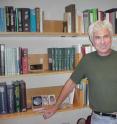Protein shown to be natural inhibitor of aging in fruit fly model
Scientists at the University of California, San Diego School of Medicine, have identified a protein called Sestrin that serves as a natural inhibitor of aging and age-related pathologies in fruit flies. They also showed that Sestrin, whose structure and biochemical function are conserved between flies and humans, is needed for regulation of a signaling pathway that is the central controller of aging and metabolism. The work, led by Michael Karin, PhD, Distinguished Professor of Pharmacology in UCSD's Laboratory of Gene Regulation and Signal Transduction, is the cover story of the March 5 issue of the journal Science. Sestrins are highly conserved small proteins that are produced in high amounts when cells experience stress. Sestrin function, however, remained puzzling until the Karin group found that these proteins function as activators of AMP-dependent protein kinase (AMPK), and inhibitors of the Target of Rapamycin (TOR). AMPK and TOR are two protein kinases that serve as key components of a signaling pathway shown to be the central regulator of aging and metabolism in a variety of model organisms, including the worm Caenorhabditis elegans, the fruit fly Drosophila melanogaster and mammals.
AMPK is activated in response to caloric restriction, a condition that slows down aging, whereas TOR is activated in response to over-nutrition, a condition that accelerates aging. Activation of AMPK inhibits TOR, and drugs that activate AMPK or inhibit TOR can delay aging in several different model organisms including mammals. But how the body keeps the activity of these two protein kinases in balance to prevent premature aging was unknown. Additionally, the presence of three different genes encoding Sestrins in mammals made it difficult to identify their exact physiological function in live animals.
The new study took advantage of the finding that the fruit fly Drosophila, whose AMPK-TOR signaling pathway functions in the same manner as its mammalian equivalent, contains a single Sestrin gene. Using a variety of genetic techniques, first author Jun Hee Lee inactivated the Sestrin gene of Drosophila and found that although Sestrin-deficient flies do not exhibit any developmental abnormalities, they suffer from under-activation of AMPK and over-activation of TOR – confirming that Sestrin is needed for keeping this pathway in check. Most importantly, the biochemical imbalance incurred by loss of Sestrin expression resulted in several age-related pathologies.
"Strikingly, the pathologies caused by the Sestrin deficiency included accumulation of triglycerides, cardiac arrhythmia and muscle degeneration that occurred in rather young flies," said Karin. "These pathologies are amazingly similar to the major disorders of overweight, heart failure and muscle loss that accompany aging in humans."
Lee and colleagues at UC San Diego and the Sanford-Burnham Institute in La Jolla, California, went on to demonstrate that feeding flies with drugs that either activate AMPK or inhibit TOR conferred protection against most of these early aging, degenerative symptoms. The researchers also found that over-activation of TOR is likely to accelerate aging of heart and skeletal muscles by disrupting an important "quality control" process called autophagy. Autophagy allows cells to rid themselves of and replace damaged mitochondria, the little power plants that provide all cells, especially muscles, with energy. However, when mitochondria get old, they produce high concentrations of reactive oxygen species (ROS), or free radicals, that can lead to tissue damage.
Karin explained that the process of autophagy – which counteracts aging – allows the replacement of "old" and defective mitochondria with "brand new" mitochondria. Sestrin-deficient flies, however, were found to exhibit accumulation of damaged mitochondria and ROS several days prior to the detection of muscle degeneration. Feeding these flies vitamin E, an antioxidant which neutralizes free radicals, prevented premature muscle degeneration and heart failure.
In future work, the Karin group plans to examine whether the mammalian Sestrins also control aging and metabolism, and whether defects in proper Sestrin expression will provide the explanation to some of the currently unexplainable degenerative diseases associated with old age.
"Maybe one day we will be able to use Sestrin analogs to prevent much of the tissue failure associated with aging, as well as treat a number of degenerative diseases, whose incidence goes up with old age, including sarcopenia and Alzheimer's disease," said Karin.
Source: University of California - San Diego
Other sources
- Protein shown to be natural inhibitor of aging in fruit fly modelfrom Science DailyFri, 5 Mar 2010, 2:14:21 UTC
- Protein shown to be natural inhibitor of aging in fruit fly modelfrom PhysorgThu, 4 Mar 2010, 19:14:41 UTC
